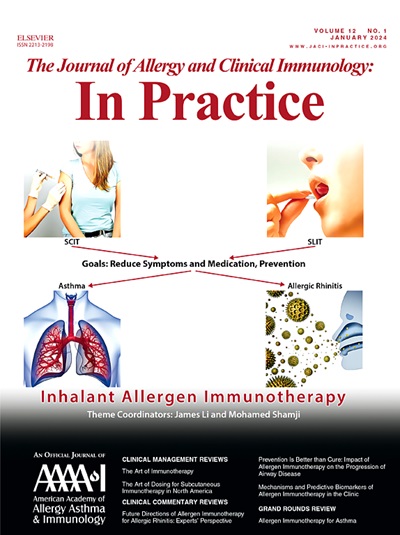Prospective Piperacillin Lymphocyte Transformation Testing in Patients With Cystic Fibrosis Receiving Regular and Desensitization Courses of Piperacillin-Tazobactam
IF 8.2
1区 医学
Q1 ALLERGY
Journal of Allergy and Clinical Immunology-In Practice
Pub Date : 2025-03-01
DOI:10.1016/j.jaip.2024.12.003
引用次数: 0
Abstract
Background
Piperacillin-tazobactam is used in patients with cystic fibrosis to treat recurrent respiratory infections. Exposure is associated with a high frequency of nonimmediate hypersensitivity.
Objective
To assess the applicability of the lymphocyte transformation test (LTT) for the diagnosis of piperacillin hypersensitivity and the influence of desensitization on piperacillin-specific T-cell responses.
Methods
Study arm 1 was an analysis of LTT responses from 58 naive/baseline tolerant patients with samples collected over a 3-year interventional phase. In study arm 2, 17 hypersensitive patients were recruited and LTTs were conducted before and after desensitization. Clinical hypersensitivity reactions in both arms were monitored over an 8-year observational period.
Results
In study arm 1, 58 patients received 611 piperacillin-tazobactam courses (range, 2-40; mean ± SD, 10.5 ± 8.1) during the interventional phase; 11 patients developed hypersensitivity. The patients who remained tolerant received 236 piperacillin-tazobactam courses in the observational period, 9 of whom developed hypersensitivity. Ten of 11 interventional phase hypersensitive patients had a positive LTT whereas one remained negative. We recorded 136 negative LTTs with 39 tolerant patients, whereas eight patients had a positive LTT and four developed hypersensitivity during the observational period. Ten LTT-positive patients in study arm 2 underwent piperacillin-tazobactam desensitization, with seven tolerating the drug. The strength of the LTT decreased during desensitization, and negative results were recorded for a minimum of 14 days. During follow-up, eight patients tolerated 62 piperacillin-tazobactam courses through desensitization.
Conclusions
The LTT is a sensitive marker of drug sensitization that could be used to inform future patient management. Desensitization is associated with attenuation of the piperacillin-specific T-cell response.
对接受哌拉西林-他唑巴坦常规疗程和脱敏疗程的囊性纤维化患者进行前瞻性哌拉西林淋巴细胞转化试验。
背景:哌拉西林-他唑巴坦用于囊性纤维化患者治疗复发性呼吸道感染。接触与非即时超敏反应的高频率有关。目的:探讨淋巴细胞转化试验(LTT)对哌拉西林过敏诊断的适用性及脱敏对哌拉西林特异性t细胞反应的影响。方法:研究一组是对58名naïve/基线耐受患者的LTT反应进行分析,这些患者的样本收集于三年的介入期。在研究组2中,招募了17名过敏患者,在脱敏前后进行ltt。在8年的观察期内监测了两组患者的临床超敏反应。结果:研究1组58例患者接受611(范围2-40;平均±SD, 10.5±8.1)个哌拉西林-他唑巴坦疗程,其中11例发生超敏反应。对哌拉西林-他唑巴坦耐受的患者在观察期内接受了236个疗程的哌拉西林-他唑巴坦治疗,其中9个出现过敏反应。10 / 11例介入期过敏患者LTT阳性,1例仍为阴性。136例LTT阴性,39例耐药,8例LTT阳性,其中4例在观察期间出现过敏反应。研究2组10例LTT阳性患者接受哌拉西林-他唑巴坦脱敏治疗,其中7例耐受该药。在脱敏过程中,LTT的强度下降,阴性结果至少记录了14天。在随访期间,8例患者通过脱敏耐受了62个哌拉西林-他唑巴坦疗程。结论:LTT是药物致敏的敏感标志物,可用于指导未来的患者管理。脱敏与哌拉西林特异性t细胞反应的衰减有关。
本文章由计算机程序翻译,如有差异,请以英文原文为准。
求助全文
约1分钟内获得全文
求助全文
来源期刊

Journal of Allergy and Clinical Immunology-In Practice
ALLERGYIMMUNOLOGY-IMMUNOLOGY
CiteScore
11.10
自引率
9.60%
发文量
683
审稿时长
50 days
期刊介绍:
JACI: In Practice is an official publication of the American Academy of Allergy, Asthma & Immunology (AAAAI). It is a companion title to The Journal of Allergy and Clinical Immunology, and it aims to provide timely clinical papers, case reports, and management recommendations to clinical allergists and other physicians dealing with allergic and immunologic diseases in their practice. The mission of JACI: In Practice is to offer valid and impactful information that supports evidence-based clinical decisions in the diagnosis and management of asthma, allergies, immunologic conditions, and related diseases.
This journal publishes articles on various conditions treated by allergist-immunologists, including food allergy, respiratory disorders (such as asthma, rhinitis, nasal polyps, sinusitis, cough, ABPA, and hypersensitivity pneumonitis), drug allergy, insect sting allergy, anaphylaxis, dermatologic disorders (such as atopic dermatitis, contact dermatitis, urticaria, angioedema, and HAE), immunodeficiency, autoinflammatory syndromes, eosinophilic disorders, and mast cell disorders.
The focus of the journal is on providing cutting-edge clinical information that practitioners can use in their everyday practice or to acquire new knowledge and skills for the benefit of their patients. However, mechanistic or translational studies without immediate or near future clinical relevance, as well as animal studies, are not within the scope of the journal.
 求助内容:
求助内容: 应助结果提醒方式:
应助结果提醒方式:


